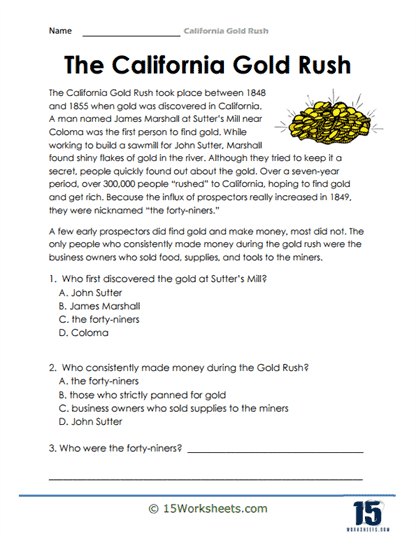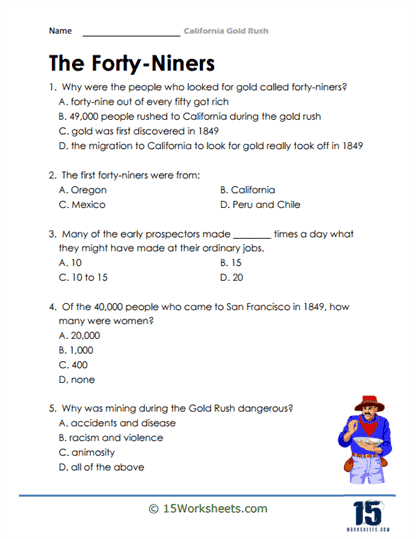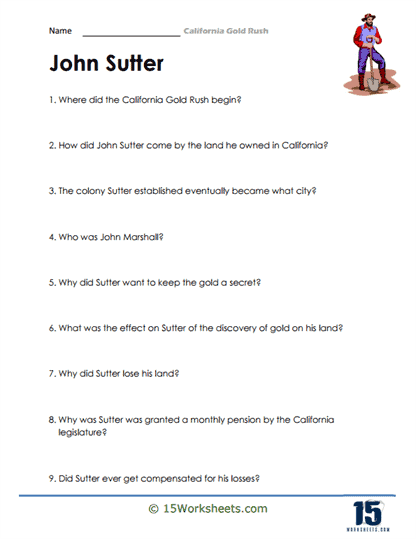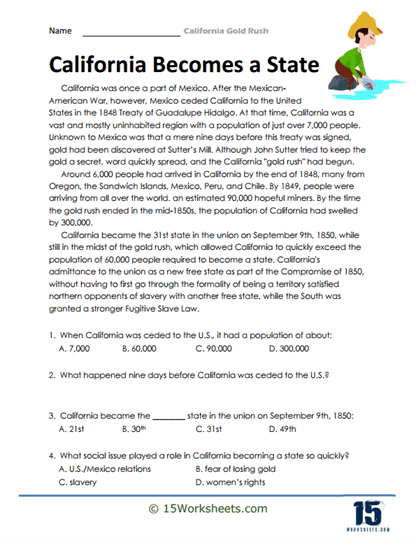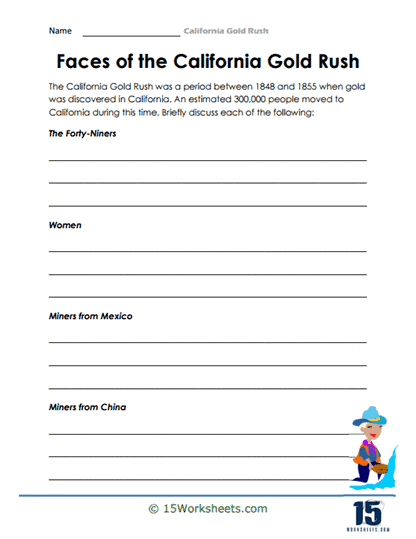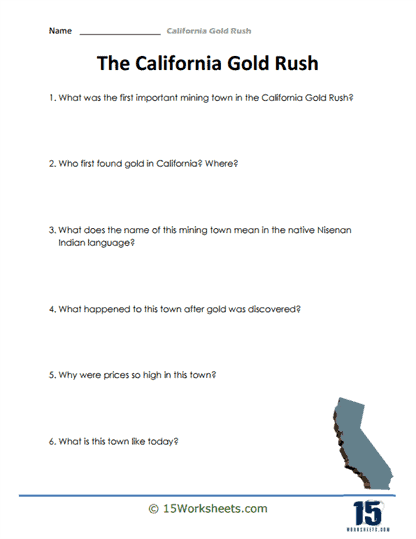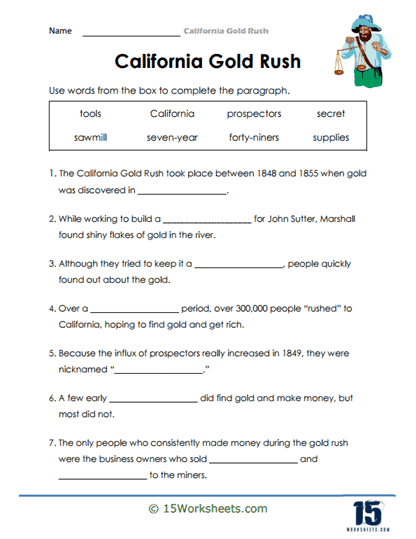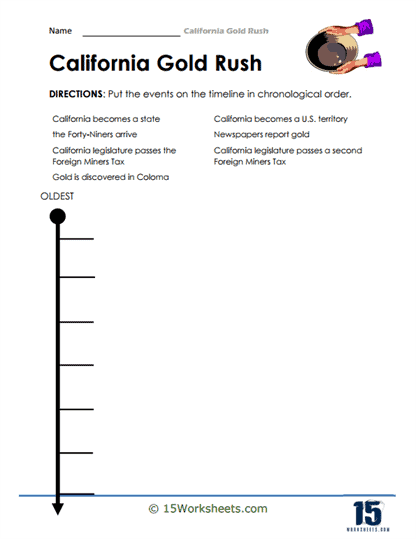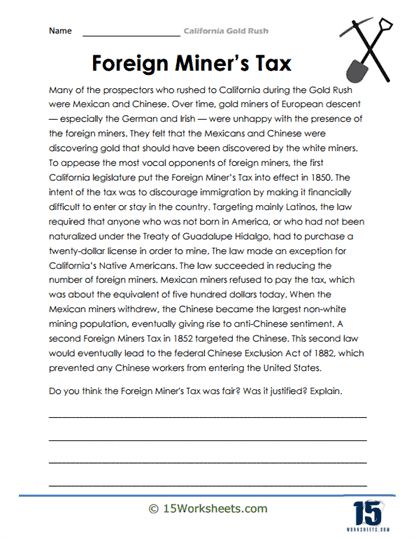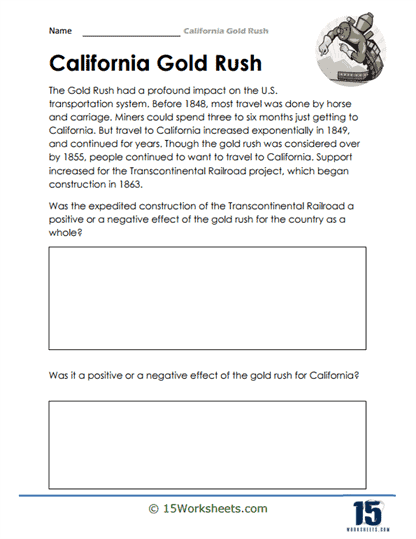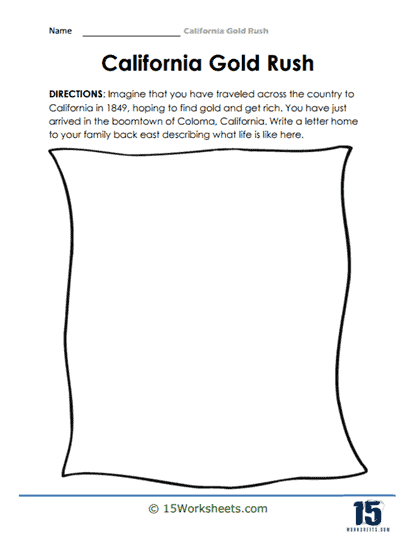California Gold Rush Worksheets
All About These 15 Worksheets
Students embark on a thrilling journey back to the mid-19th century with this comprehensive series of 15 worksheets on the California Gold Rush. This collection is designed to transport students to the bustling era of the gold rush, where dreams of striking it rich lured thousands of adventurers to the untamed lands of California. Through engaging activities and thought-provoking exercises, students will gain a deeper understanding of the causes, impact, and lasting legacy of this transformative event in American history. Through these worksheets, students will:
- Explore the historical context, including the discovery of gold at Sutter’s Mill, the rush of prospectors, and the impact on the region and the nation;
- Demonstrate their broad knowledge on the several facets of this period in history through various writing prompts, multiple choice and true or false questions, and more;
- Discuss the roles of different groups of people during this period in history;
- Examine the impact of the gold rush on the state of California as they explore the population boom, the development of infrastructure and cities, the impact on Native American communities, and the lasting changes brought about by the rush for gold;
- Learn the correct sequence of the key events;
- And describe this historic period by putting themselves in the shoes of those who witnessed the events unfold first-hand.
Engaging with this series of worksheets will transport students back to the exhilarating era of the California Gold Rush, fostering a deep understanding of its historical significance, the experiences of miners, and its lasting impact on American history. Through a wide range of activities and thought-provoking exercises, students will develop critical thinking skills, empathy for the miners, and a greater appreciation for the transformative events that shaped the nation’s westward expansion.
Why Was the California Gold Rush a Defining Moment in American History?
The California Gold Rush was a remarkable period in American history, characterized by mass migration, rapid economic growth, and profound social and cultural changes. Sparked by the discovery of gold in 1848, the Gold Rush attracted hundreds of thousands of fortune-seekers from around the world, transforming California from a remote Mexican territory into a thriving American state.
Origins of the California Gold Rush
The California Gold Rush began with the chance discovery of gold at Sutter’s Mill in Coloma, California, on January 24, 1848. James W. Marshall, a carpenter and sawmill operator working for Swiss immigrant John Sutter, found shiny flakes of gold in the tailrace of the mill. Although Sutter and Marshall attempted to keep the discovery a secret, word quickly spread, and soon thousands of people flocked to the area in search of gold.
The timing of the discovery was significant, as it occurred just days before the signing of the Treaty of Guadalupe Hidalgo on February 2, 1848, which ended the Mexican-American War and ceded California and other southwestern territories to the United States. This coincidental timing facilitated American expansion into the newly acquired territory and fueled interest in the gold fields of California.
The Journey to California
As news of the gold discovery spread, people from all walks of life began to make the arduous journey to California in pursuit of wealth and prosperity. The first wave of fortune-seekers, known as the “Forty-Niners,” arrived in California in 1849. Many traveled overland along the California Trail or the Old Spanish Trail, facing harsh conditions, disease, and even death. Others chose to sail around Cape Horn at the southern tip of South America or to cross the Isthmus of Panama, both perilous journeys in their own right.
The Gold Rush attracted a diverse group of people, including Americans from the eastern states, immigrants from Europe, Latin America, and Asia, and even former slaves and free African Americans. The population of California exploded from approximately 14,000 non-native residents in 1848 to over 300,000 by 1854, transforming the region into a cultural melting pot.
Key Events and Their Impact During the California Gold Rush
The California Gold Rush, which began in 1848, was a transformative event in American history. It was marked by a series of key events that shaped the course of the rush and had a significant impact on California and the nation as a whole.
- Discovery at Sutter’s Mill: The gold rush was sparked by the discovery of gold at Sutter’s Mill in Coloma, California, in January 1848. James W. Marshall, a carpenter working for John Sutter, found gold flakes in the American River. News of the discovery spread rapidly, setting off a massive influx of prospectors seeking their fortunes.
- Gold Fever and the Rush to California: The news of gold spread like wildfire, igniting a phenomenon known as “gold fever.” Thousands of people from all walks of life flocked to California in search of gold. These prospectors, known as “Forty-Niners,” came from all over the United States and even from around the world.
- Mining Methods and Challenges: Prospectors employed various mining methods to extract gold from rivers, streams, and hillsides. Placer mining involved using pans, sluices, and later, hydraulic mining techniques. The harsh conditions, limited resources, and competition for gold created numerous challenges for miners.
- Development of Mining Towns: As prospectors arrived in California, mining towns sprang up throughout the region. These towns, such as San Francisco, Sacramento, and Stockton, experienced rapid growth as people sought supplies, services, and entertainment. Many of these towns became important centers of commerce and transportation.
- Cultural and Social Impact: The gold rush had a profound impact on California’s demographics and cultural landscape. The influx of people from diverse backgrounds led to a vibrant multicultural society. Chinese immigrants played a significant role in mining and contributed to the development of the state.
- Environmental Impact: The methods used in gold mining, particularly hydraulic mining, caused significant environmental damage. Massive amounts of sediment were washed into rivers, polluting water sources and devastating fish habitats. This led to the passage of laws and regulations aimed at mitigating environmental damage.
- Economic Boom and Infrastructure Development: The gold rush fueled a massive economic boom in California. Gold was the primary driver of economic activity, attracting investment and leading to the development of infrastructure, including roads, railways, and telegraph lines. The rush also stimulated agriculture and other industries to support the growing population.
- Statehood and Long-Term Effects: The population surge resulting from the gold rush played a pivotal role in California’s path to statehood. California was admitted to the Union as the 31st state in 1850. The gold rush also had long-lasting effects on the region, including the growth of urban centers, the expansion of agriculture, and the establishment of California as a land of opportunity.
The California Gold Rush was a transformative event, drawing people from around the world, stimulating economic growth, and shaping the future of California and the United States. Its impact can still be seen today in the cultural diversity, economic vitality, and historical legacy of the state.

